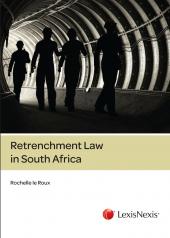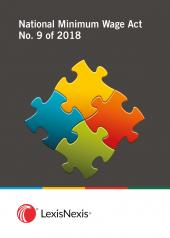Retrenchment Law in South Africa
Retrenchment Law in South Africa provides a detailed and comprehensive analysis of retrenchment law in South Africa.
Select a format
One Year Subscription Only Terms
Subscribers receive the product(s) listed on the Order Form and any Updates made available during the annual subscription period. Shipping and handling fees are not included in the annual price.
Subscribers are advised of the number of Updates that were made to the particular publication the prior year. The number of Updates may vary due to developments in the law and other publishing issues, but subscribers may use this as a rough estimate of future shipments. Subscribers may call Customer Support at 800-833-9844 for additional information.
Subscribers may cancel this subscription by: calling Customer Support at 800-833-9844; emailing customer.support@lexisnexis.com; or returning the invoice marked 'CANCEL'.
If subscribers cancel within 30 days after the product is ordered or received and return the product at their expense, then they will receive a full credit of the price for the annual subscription.
If subscribers cancel between 31 and 60 days after the invoice date and return the product at their expense, then they will receive a 5/6th credit of the price for the annual subscription. No credit will be given for cancellations more than 60 days after the invoice date. To receive any credit, subscriber must return all product(s) shipped during the year at their expense within the applicable cancellation period listed above.
Product description
Retrenchment Law in South Africa provides a detailed and comprehensive analysis of retrenchment law in South Africa.
The author provides new, critical insight into the interplay between case law and legislative developments.
The 2014 amendments to the Labour Relations Act are considered as well as the potential unintended consequences of these amendments (such as the impact of ss 198 A (b) (ii) and s 198 B (5) on an employer's ability to retrench). The book examines the meaning of the term operational requirements with extensive reference to case law and use of creative examples and hypotheticals.
Retrenchment Law in South Africa covers complex issues such as bumping and timing periods in the case of large-scale retrenchments. The author provides useful international comparisons in particular the ILO convention and the EUs Directive on Collective Redundancies. Practitioners and academics will benefit from this useful examination of retrenchment law. Who is the book aimed at? Labour law practitioners, post graduate students, union officials, commissioners arbitrators, HR Directors and judges.
Table of contents
Retrenchment law in context
Introduction
Retrenchment and redundancy explained
Historical overview and national and international legislative framework
Overview Processing of, and remedies for, a claim of unfair retrenchment
Operational requirements
Introduction
Distinguishing between operational requirements dismissals and dismissals for misconduct or incapacity
Distinguishing between an operational requirement dismissals and a dismissal because of a strike action (or other reasons listed in section 187)
The relationship between sections 187(1)(c), 188 and 189
Defining operational requirements
Retrenchment an employee on a fixed-term contract
Consulting for a fair retrenchment
Introduction — understanding the relationship between substance and procedure
The implications of non-compliance with procedural requirements
Consulting in terms of section 189
The notice in terms of section 189(3)
The consulting parties
Consulting in the case of insolvency and business rescue
The nature of the consultation process
Disclosure of information
The consultation agenda — key procedural and substance fairness
Introduction
Avoiding or minimising retrenchments
Timing and mitigation adverse effects of the retrenchment
Selecting employees for retrenchment
Severance pay
Large-scale retrenchments
Introduction
The formula for application
Facilitation or not
Procedural unfairness
Giving Notice
Industrial Action
Substantive Fairness
A Fair reason for retrench
Introduction
General
The Jurisprudential evolution of the test for substantive fairness
Establishment fairness
The rise and fall of section 189A(19)
Selection criteria




